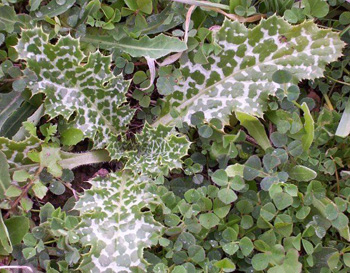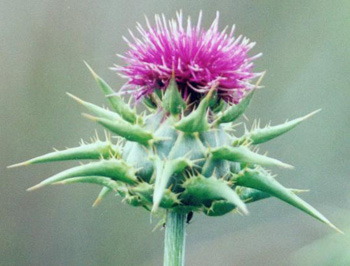Contents:
Common Names | Parts Usually Used | Plant(s) & Culture | Where Found | Medicinal Properties | Biochemical Information
Legends, Myths and Stories | Uses | Formulas or Dosages | How Sold | Resource Links | Bibliography
Scientific Names

- Silybum marianum L.
- Carduus marianus
- Compositae
- Composite family
Common Names
- Holy thistle
- Marythistle
- St. Mary’s thistle
Parts Usually Used
Fruits (contain the highest concentration), seeds and leaves
Back to Top

Description of Plant(s) and Culture
A stout, annual or biennial plant, grows to 6 feet in height; the branched, shining-brown stem grows 1-3 feet high and bears large, alternate, dark green, shiny leaves with spiny, scalloped edges and white spots along the veins. The upper leaves clasp the stem. The small, composite, solitary, spherical, reddish-purple flower heads at the ends of the stalks, subtended by spiny bracts with a silky crown of hair, which is soon shed, appear from June to August.
Back to Top
Where Found
Found in dry, rocky soils in southern and western Europe and in some parts of the United States. Common in California.
Back to Top
Medicinal Properties
Cholagogue (stimulates flow of bile), liver tonic, stimulant, demulcent, antidepressant, galactagogue
Back to Top
Biochemical Information
Active flavonoid silymarin (a unique type of flavonoid with antioxidant ability).
Back to Top
Legends, Myths and Stories
Milk thistle helps regenerate liver cells and helps cleanse the liver of dangerous toxins. In several European studies performed in the 1970’s on rats, animals who had their livers partially removed experienced a regeneration of liver cells after receiving milk thistle extract.
This herb is extremely popular in Europe as a tonic for the liver, the body’s second largest organ. This herb contains a flavonoid called silymarin that has been shown to have a direct effect on liver cells. Known as vitamin P, flavonoids are substances found in plants that often work in conjunction with vitamin C and offer many other health benefits. Often referred to as the body’s “chemical factory,” the liver plays a critical role in maintaining good health. It produces bile, which is necessary for the break-down of fats. It detoxifies poisons that enter our bloodstream, such as nicotine, alcohol, and pollutants such as carbon monoxide. It breaks them down from potentially lethal substances into those that are less destructive to our bodies. The liver is also the site where vitamins A, D, E, and K are stored. Numerous European studies sow that this herb enhances overall liver function, as well as stimulates the production of new liver cells.
The herb is beneficial for those suffering from hepatitis, inflammation of the liver, or cirrhosis of the liver (a condition often caused by excessive alcohol intake). This herb is also recommended for all smokers or anyone exposed to pollutants in the workplace.
Back to Top
Uses
Young leaves eaten as a vegetable.
A tonic and anti-depressant. Milk Thistle has a tonic effect on the heart, brain, and kidneys. It is said to restore a memory impaired by old age or sickness. Used for all liver disorders such as jaundice, liver disorders, and hepatitis. Stimulates the production of new liver cells and prevents formation of damaging leukotrienes. Protects the kidneys and is beneficial in cases of psoriasis. Good for gallstone colic.
Use the leaves for common stomach problems like lack of appetite, and dyspepsia.
Clinical trials have found it especially useful in the treatment of Amanita mushroom poisoning; it is credited with saving a number of lives in Europe.
Research suggests seed extracts may have therapeutic possibilities in liver cirrhosis.
Back to Top
Formulas or Dosages
Infusion: 1 1/2 oz. leaves and chopped stalk, add to 1/2 pint water. Take a wineglassful every day.
Also; infusion: steep 1 tsp. powdered seeds with water, take 4-5 times per day.
Tincture: take 15 to 25 drops, 4 or 5 times per day.
Back to Top
How Sold
Capsules: take 1 capsule 3 times daily.
Commercial preparations of the seed extracts are manufactured in Europe.
Back to Top
Resource Links
LiveStrong.com: Feverfew & Milk Thistle
LiveStrong.com: Does Milk Thistle Improve Sleep?
LiveStrong.com: Milk Thistle & Dandelion on an Empty Stomach
LiveStrong.com: Milk Thistle & Aloe Vera Combination for the Liver
LiveStrong.com: Thistle & Clover
LiveStrong.com: How Exactly Does Milk Thistle Work to Protect the Liver?
LiveStrong.com: Silymarin & Feverfew
LiveStrong.com: Milk Thistle and Antioxidants
LiveStrong.com: Thistle Treatment
LiveStrong.com: Can Milk Thistle Help Lower Cholesterol?
LiveStrong.com: What Are the Benefits of Milk Thistle & Ginger?
LiveStrong.com: Silybum Marianum Vs. Milk Thistle Seed Extract
National Center for Complementary & Alternative Medicine: Milk Thistle
Memorial Sloan-Kettering Cancer Center: Milk Thistle
University of Maryland Medical Center: Milk Thistle
PubMed.gov: Medicinal herbs: answers and advice, part 1.
PubMed.gov: Milk thistle in liver diseases: past, present, future.
Bibliography
![]() The Herb Book
The Herb Book, by John Lust, Bantam Books, 666 Fifth Avenue, New York, NY. copyright 1974.
![]() The Complete Medicinal Herbal
The Complete Medicinal Herbal, by Penelope Ody, Dorling Kindersley, Inc, 232 Madison Avenue, New York, NY 10016, First American Edition, copyright 1993
![]() Eastern/Central Medicinal Plants
Eastern/Central Medicinal Plants, by Steven Foster and James A. Duke., Houghton Mifflin Company, 215 Park Avenue South, New York, NY 10000
 The Magic of Herbs
The Magic of Herbs, by David Conway, published by Jonathan Cape, Thirty Bedford Square, London, England. (Out of print)
 Earl Mindell’s Herb Bible
Earl Mindell’s Herb Bible, by Earl Mindell, R.Ph., Ph.D., Simon & Schuster/Fireside, Rockefeller Center 1230 Avenue of the Americas, New York, New York 10020
Herbal Gardening, compiled by The Robison York State Herb Garden, Cornell Plantations, Matthaei Botanical Gardens of the University of Michigan, University of California Botanical Garden, Berkeley., Pantheon Books, Knopf Publishing Group, New York, 1994, first edition
![]() Planetary Herbology
Planetary Herbology, by Michael Tierra, C.A., N.D., O.M.D., Lotus Press, PO Box 325, Twin Lakes. WI 53181., Copyright 1988, published 1992
![]() Prescription for Nutritional Healing, Fifth Edition: A Practical A-to-Z Reference to Drug-Free Remedies Using Vitamins, Minerals, Herbs & Food Supplements
Prescription for Nutritional Healing, Fifth Edition: A Practical A-to-Z Reference to Drug-Free Remedies Using Vitamins, Minerals, Herbs & Food Supplements, by James F. Balch, M.D. and Phyllis A. Balch, C.N.C., Avery Publishing Group, Inc., Garden City Park, NY
 Taber’s Cyclopedic Medical Dictionary
Taber’s Cyclopedic Medical Dictionary, 15th Edition, F. A. Davis Company, 1915 Arch Street, Philadelphia, PA 19103
 A Useful Guide to Herbal Health Care
A Useful Guide to Herbal Health Care, HCBL (Health Center for Better Living).,1414 Rosemary Lane, Naples, FL 34103., Special Sale Catalog, 1996
![]() Webster’s New World Dictionary
Webster’s New World Dictionary, Third College Edition, Victoria Neufeldt, Editor in Chief, New World Dictionaries: A Division of Simon & Schuster, Inc., 15 Columbus Circle, New York, NY 10023
 How Indians Use Wild Plants for Food, Medicine & Crafts
How Indians Use Wild Plants for Food, Medicine & Crafts, by Frances Densmore, Dover Publications, Inc., 180 Varick Street, New York, NY 10014, first printed by the United States Government Printing Office, Washington, in 1928, this Dover edition 1974
 The Healing Plants
The Healing Plants, by Mannfried Pahlow, Barron’s Educational Series, Inc. 250 Wireless Blvd., Hauppauge, NY 11788, 1992
